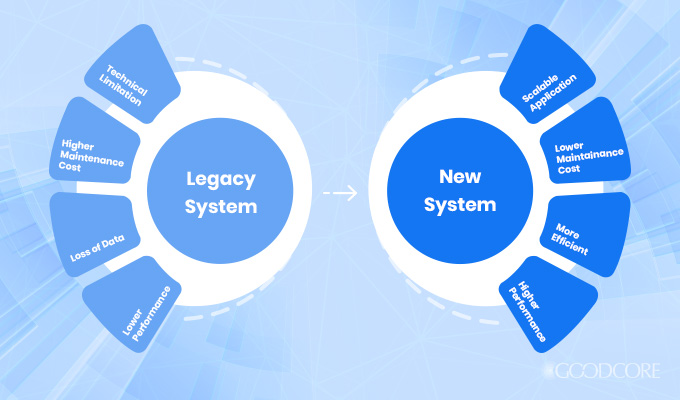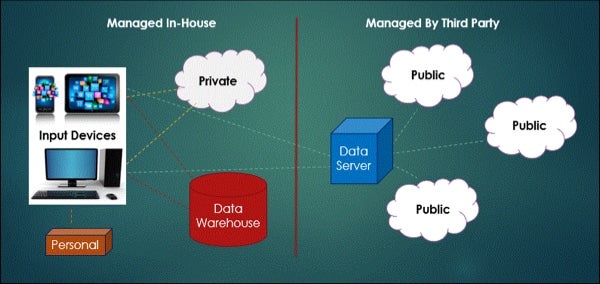Legacy conditions refer to a systems difficulty or inability to be maintained supported or improved. For example for most banks the customer accounting system was one of their earliest systems.
Agile Legacy System Analysis And Integration Modeling
Information technology has a tendency to age very quickly as architectural techniques software designs programming languages operating systems and hardware progress.

Examples of legacy systems. A major platform with no functional replacement yet still supported and compatible with other IT assets but which does not receive security updates anymore. There is one common feature in each of the examples of old legacy systems mentioned above. A legacy systems older technology wont allow it to interact with newer systems.
However Windows XP is still used if not widely. Legacy systems embrace a large number of technologies making the development of tools to cope with legacy systems evolution a tedious and time-consuming task. For example a large mainframe may use a 64-bit Java while a Linux platform might utilize code from the 1960s.
Banks energy companies including nuclear plants manufacturing of all types process control the defense industry transportation hospitals insurance and more. The examples of enterprise-level legacy software can be quite different. What a legacy system does now for the company is all it will ever do.
In reality however legacy applications still power important business processes in plenty of other companies around the world. On a more basic level legacy operating systems such as Microsoft Windows 2008 may no longer be receiving basic security updates to fix long standing security flaws. A number of examples of such legacy systems can be found across some major federal organizations.
They are maintained because it is too risky to replace them. For many organizations retiring legacy systems is not an option due to time and resource investment. Examples include systems to handle customers accounts in banks computer reservations systems air traffic control energy distribution power grids nuclear power plants military defense installations and systems such as the TOPS database.
To deal with the myriad of technological combinations found in modernization roadmaps model-driven approaches and tools offer the requisite abstraction level to build up mature and flexible modernization solutions. The 24 CFO Act agencies reported 94 successful modernizations in the last five years ranging from transforming COBOL code to Java migrating email to the cloud and redesigning a legacy mainframe. All of them were using Oracle Microsoft or IBM software products.
The system still meets the needs it was originally designed for but doesnt allow for growth. A large mainframe may use a 64-bit Java while a Linux platform might utilize code from the 1960s. As information technology pioneers they have created many.
You could also run into issues with various communications systems that begin to have problems communicating with more modern systems because they lack support for modern standards. A legacy system is a technology that is out of date to the point of representing an operational risk to a business. A legacy system is not necessarily defined by age.
Legacy conditions refer to a systems difficulty or inability to be maintained supported or improved. They use legacy applications running on an obsolete mainframe for core business operations such as high-volume data processing. It is the engine that drives your Zero Trust security strategy.
Examples of legacy systems mentioned in Spiceworks Hardware in power plants thats so old the only functioning replacement parts are in the Smithsonian Museum and the only qualified techs that can repair it are all retired A still-in-use voicemail system that uses both software and hardware from 1993. Stealth security is seamlessly woven into the fabric of your entire network. Legacy systems are everywhere.
A legacy system is outdated computing software andor hardware that is still in use. Windows XP as an example of a legacy system. Here are just a few cases which can be labeled as legacy software to get a better idea of what it can encompass.
In 2014 Microsoft ended its support for Windows XP and launched newer versions of it. A legacy system is usually older than five years of age. Legacy may refer to lack of vendor support or a systems incapacity to meet organizational requirements.
According to a Flexera report these three IT service providers were among the top manufacturers of IT products with end-of-life and end-of-support status in 2018. Legacy systems are often business-critical systems. For example Windows XP was first introduced in 2001 and was widely used by a lot of users globally.
Organisational policies and procedures may rely on this system. Examples include hardware in power plants manufacturing machines controlled by computers running MS-DOS or outdated financial systems. Surprisingly enough legacy systems can be found across many organizations.
Fine-tuned over the years these systems are adapted to deliver specific functionality. At Stromasys we work with organizations of all sizes and across just about every vertical with production or business critical environments.

